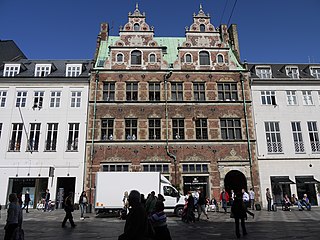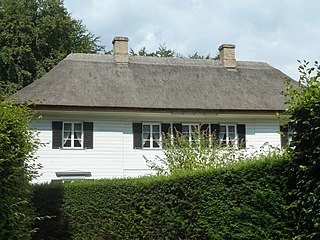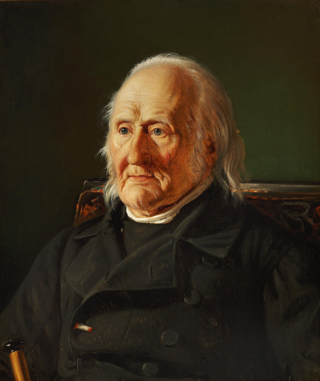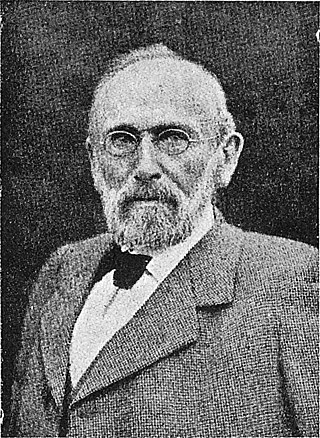
Oscar Wanscher (19 March 1846 - 7 March 1906) was a Danish surgeon.

Oscar Wanscher (19 March 1846 - 7 March 1906) was a Danish surgeon.
Wanscher was born on 19 March 1846 in Copenhagen, the son of paper merchant Wilhelm Wanscher (1802–82) and Karen Johanne Juliane Wegener (1814–79). He matriculated from.Westen's institute and earned a Master of Medicine degree from the University of Copenhagen in 1871. He then went on to study eye diseases for two years at E. Grut's eye clinic. [1] In 1872–84, heworked at Copenhagen Municipal Hospital. In 1877, he defended his disertation (Om Diphtheritis og Croup). [1]
In 1879, Wanscher became a corps physician in the army and acting chief physician at the Garrison Hospital. He was instrumental in introducing ether at the hospital as a replacement for chloroform as an anesthetic. In 1885, he unsuccessfully competed with E. A. Tschernin and O. Bloch for the position as Mathias Saxtorph's successor at the university (in. In 1890, he left the army. In 1892, he succeeded P. Plum as chief surgeon at Frederiks Hospital. Wanscher had for some time struggled with depressions. His mental issues made it increasingly difficult for him to continue his career. His publications included the first section of operativ Kirurgi (1898). In 1900, he was appointed professor extraordinary in surgical pathology. [1]

On 19 January 1881, Wanscher married Johanne Margrethe Hage (1850-1929=. She was the daughter of businessman Christopher Theodor Friedenreich Hage (1819–72) and Nannie (Nancy) Amelie Margrethe Hammerich (1827-1902). [1] They were the parents of a daughter and two sons. The daughter Ellen Margrethe Wanscher (1883-1867) married the architect Mogens Lassen. [2]
Ole Wanscher was a Danish furniture designer. He was one of the leading figures in the Scandinavian Design movement, at a time when Scandinavian Design achieved worldwide popularity.
Events from the year 1846 in Denmark.
Andreas Jeppe Iversen, usually known as A.J. Iversen, was a Danish cabinetmaker and furniture designer. From the 1920s, his collaboration with architects and designers paved the way for the style which later became known as Danish modern.

Barchmann Mansion is a Baroque style town mansion overlooking Frederiksholm Canal in central Copenhagen, Denmark. Built in the early 1740s to designs by Philip de Lange, it is also known as the Wedell Mansion after the current owner. It was listed in the Danish registry of protected buildings and places in 1918. An extension from 1748 is now home to Johan Borup's Folk High School.

The Matthias Hansen House, formerly also known as the Schoustrup House, is a Renaissance-style townhouse on Amagertorv in central Copenhagen, Denmark. Built in 1616, it is one of few buildings of its kind which has survived the Copenhagen Fires of 1728 and 1795. The building is now home to a flagship store for the Royal Copenhagen porcelain factory.

Nivaagaard is a historic property in Nivå in the northern outskirts of Copenhagen, Denmark. It is now home to an art gallery and the park is open to the public.

The Jens Lauritzen House is a Neoclassical property at Nytorv 7 in the Old Town of Copenhagen, Denmark. Home to the Association of Folk High Schools in Denmark, the building is now also known as Højskolernes Hus.

Gammel Skovgård is a former country house in Gentofte Municipality in the northern suburbs of Copenhagen, Denmark. It was originally located at the site where Skovgård School in Ordrup is now located but moved to its current site at Krathusvej 36 when the school was built in the 1950s.

Peter Anton Alfred Hage was a Danish merchant, politician, landowner, patron of the arts and philanthropist.

Christopher Friedenreich Hage, was a Danish merchant on the island of Møn. He was the father of Alfred Hage, Hother Hage, Johannes Dam Hage and Bolette Hage.

Gustav Adolph Hagemann was a Danish engineer and businessman. He was chief technical officer of the Danish Sugar Factories from 1872 to 1897 and then served as chairman of the board until 1916. He owned several sugar plantations on Saint Croix in the Danish West Indies.

Jens Friedenreich Hage was a Danish merchant and landowner.

Gunnar Asgeir Sadolin was a Danish businessman.

Jens Ernst Wegener was a Danish educator and pedagogical writer. He was principal of Jonstrup Seminarium outside Copenhagen from 1819 to 1838. He was the father of painter Gustav Theodor Wegener.

Johan Georg Ludvig Manthey was a Danish pharmacist. He owned the Lion Pharmacy in Copenhagen from 1791 to 1805, managed Ørholm and Brede Works from 1805 to 1811 and served as director of the Royal Copenhagen Porcelain Manufactory from 1796 to 1812. He lived on the Falkensteen estate at Slagelse from 1812.

Lieutenant General Kjeld Georg Hilligsøe HillingsøSK BVO is a Danish retired general. He is also the father of the actress Ellen Hillingsø.

Johan Ludvig Ammentorp was a Danish medical doctor. He served as Chief Physician of the Medical Corps (stabslæge) from 1911 and as Physician General (generallæge) from 1916 to 1930.

Gammel Strand 42 is a historic property overlooking Slotsholmens Kanal and Slotsholmen in Copenhagen, Denmark. The building was constructed as part of the rebuilding of the city following the Copenhagen Fire of 1795. It listed on the Danish registry of protected buildings and places in 1945. Notable former residents include the surgeon Ludwig Lewin Jacobson, naval officer Lorentz Fjelderup Lassen, jurist F.C. Bornemand (1810–1861) and artists Harald Slott-Møller (1864–1937) and Agnes Slott-Møller.

Wilhelm Wanscer was a Danish paper merchant and art collector, remembered above all for his associations with the philosopher Søren Kirkegård and some of the leading Danish Golden Age artists. He was the father of surgeon Oscar Wanscher and industrialist Axel Wanscher, grandfather of art historian Vilhelm Wanscher and great-grandfather of the designer Ole Wanscher.
Sindinggård is a manior house situated nexct to Sinding Church in Herning Municipality, Denmark. The oldest part of the three-winged main building was constructed for Franz Ranzau in 1730. It was listed in the Danish registry of protected buildings and places in 1939.